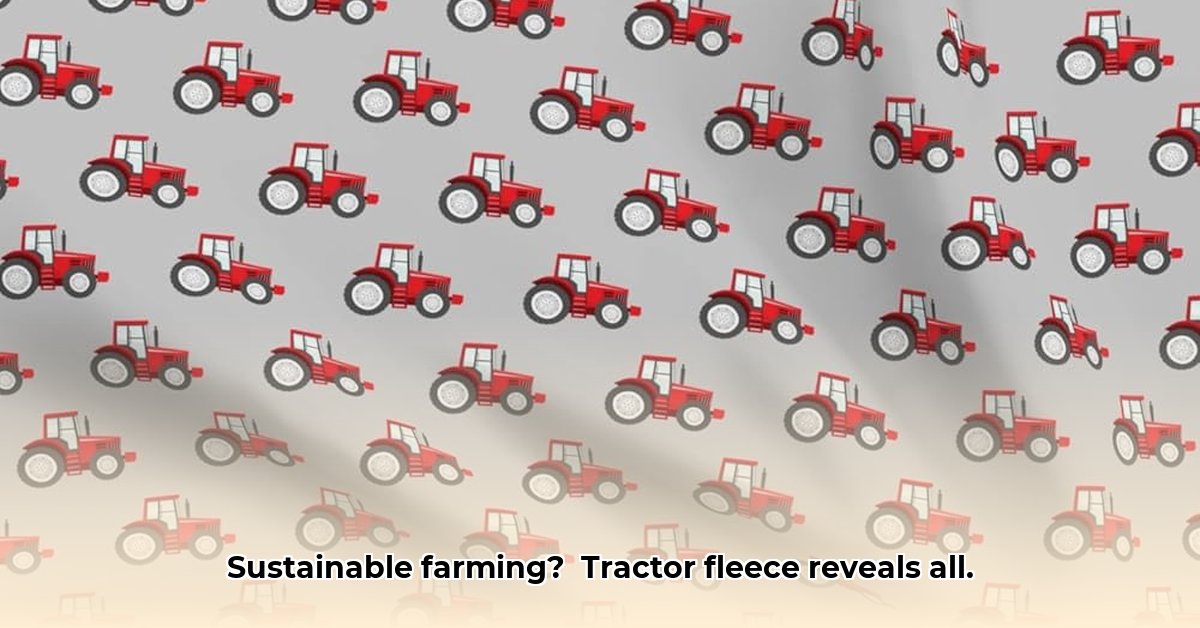
Tractor fleece fabric is emerging as a potential game-changer in sustainable agriculture. This durable, weather-resistant textile offers a range of applications, promising increased efficiency and reduced environmental impact. But how does it stack up against traditional farming materials? Let's explore its properties, environmental footprint, economic viability, and future prospects. For more on sustainable soil amendments, check out this resource.
Properties and Applications of Tractor Fleece Fabric
Tractor fleece boasts impressive properties. Its high durability extends the lifespan of covered equipment, reducing waste and replacement costs. Its water resistance protects machinery and crops from inclement weather. Critically, its breathability prevents overheating, a major advantage in warmer climates.
These characteristics translate into diverse agricultural applications. It can shield seedlings from pests and frost, act as greenhouse insulation to maintain optimal temperatures and reduce energy consumption, and even serve as a durable, protective layer for farm equipment reducing maintenance costs. Could this versatile fabric revolutionize how we protect our crops and equipment?
Environmental Impact of Tractor Fleece Fabric: A Lifecycle Assessment
Assessing the environmental impact of tractor fleece requires a comprehensive lifecycle assessment (LCA). This involves examining its entire lifecycle, from raw material sourcing to disposal. While some sources use recycled polyester, thus reducing reliance on virgin materials and landfill waste, the manufacturing process itself consumes energy and resources. The potential for microplastic shedding during use and the difficulty of complete biodegradability remain concerns. Ongoing research is crucial to fully quantify its environmental footprint compared to conventional alternatives. Is the overall impact truly more sustainable?
Economic Viability: Cost-Effectiveness on the Farm
The initial cost of tractor fleece fabric may be higher than traditional materials like plastic sheeting. However, its durability translates to longer lifespan and reduced replacement costs. Potential savings on pesticides (due to improved crop protection), decreased energy consumption in greenhouses, and less frequent equipment replacement could considerably offset this initial outlay. Precise cost-benefit analysis will vary depending on scale of operation and specific farm conditions—does it create long-term value?
Stakeholder Perspectives: Paving the Way for Adoption
Widespread adoption of tractor fleece depends on the collaborative efforts of various stakeholders. Farmers need demonstrable proof of its cost-effectiveness and improved yields. Manufacturers must adopt sustainable production methods and prioritize transparency in material sourcing. Researchers need to refine LCA methodologies and address concerns such as microplastic shedding. Finally, policymakers can encourage adoption through financial incentives and regulations that support sustainable agricultural technologies. What steps are essential to ensure a successful transition?
Future Trends and Challenges: Looking Ahead to a Sustainable Future
Scaling up production sustainably, developing biodegradable variants, and addressing challenges like microplastic shedding will be key to the future success of tractor fleece. Further research into the long-term environmental impact and economic viability across diverse farming systems is needed. However, initial signs suggest promising potential for this material to contribute significantly to a more sustainable agricultural future. Can we overcome these hurdles and unlock its full potential?
Recommendations for Responsible Adoption
To maximize the positive impact of tractor fleece fabric, we recommend:
- Farmers: Conduct pilot studies, carefully monitoring the cost-effectiveness and environmental benefits on your farm.
- Manufacturers: Prioritize sustainable manufacturing processes, transparency in material sourcing, and explore biodegradable alternatives.
- Researchers: Continue refining LCA methodologies and exploring innovative solutions for end-of-life management.
- Policymakers: Implement financial incentives, support research and development, and establish clear regulations for responsible disposal.
Comparing Tractor Fleece to Conventional Alternatives
Initial data suggests potential advantages for tractor fleece:
| Feature | Tractor Fleece Fabric | Conventional Alternatives (e.g., Plastic Sheeting) |
|---|---|---|
| Durability | High | Low |
| Water Resistance | Excellent | Good, but degradation possible |
| Breathability | Moderate | Low |
| Environmental Impact | Potentially lower (requires further research) | Generally higher |
| Initial Cost | Higher | Lower |
Tractor fleece fabric presents a compelling opportunity to enhance the sustainability of agricultural practices. However, thorough research, collaboration among stakeholders, and strategic policy intervention are crucial to ensuring its responsible and impactful adoption. The future of sustainable farming may indeed rely on innovations like this.